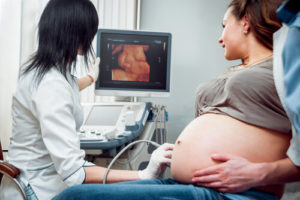Placenta Previa

Placenta previa is typically found during the second trimester during a routine ultrasound. This condition occurs when the placenta lies near the cervix or partially or completely covers the opening of the cervix.
Placenta previa is experienced in about 1 out of every 200 pregnancies and can be extremely serious. It may cause excessive bleeding, posing a significant danger to both a mother and her baby. If you or your child were harmed due to misdiagnosis or mistreatment of this birth complication, please call Stern Law, PLLC at (800) 462-5772 to discuss your claim for free.
What are the causes and risk factors associated with placenta previa?
Doctors are not exactly certain what causes placenta previa. However, there are a number of suspected causes and risk factors associated with the condition, such as:
- Scarring of the uterine lining
- An overly large placenta (typically caused by having had 5 or more children or multiples)
- An abnormally shaped uterus
- Previous cesarean section(s)
- A history of uterine fibroids
- Women who have had a history of placenta previa
- Carrying multiples, such as twins, triplets or more
- Having had a dilation and curettage (D&C)
- A woman who is of advanced maternal age (35 or older)
- A woman of Asian descent
- Smoking or using drugs during pregnancy
What are the signs and symptoms of a placenta previa?
Placenta previa is a condition that sometimes manifests no signs and symptoms. However, others may experience one or more of the following:
- Sudden and often painless vaginal bleeding (typically bright red in color) that may range from light to heavy
- Symptoms of early labor, including back pain, cramps, pain and pressure in the abdominal and pelvic regions
- Medium to severe bleeding during the first trimester
- Vaginal bleeding during the second or third trimesters
What are the complications associated with placenta previa?
If you are diagnosed with placenta previa, it is important for your doctor to monitor you closely so that the following complications do not develop:
- Bleeding – One of the biggest concerns with placenta previa is the risk that it can cause severe vaginal bleeding during labor, delivery or post-partum. In other words, the bleeding can rise to the level of hemorrhaging, which can be life threatening to you and your baby.
- Preterm baby – Another major complication associated with placenta previa is the need to perform an emergency delivery should the condition worsen or become severe. This can result in a child being born prematurely, often requiring treatment in a neonatal intensive care unit after birth.
How is placenta previa diagnosed?
A definitive diagnosis of placenta previa may require the use of both an abdominal and transvaginal ultrasound (an ultrasound that is performed through inserting a wand-like device into the vagina). In rare instances, a doctor may report to the use of an MRI to more clearly ascertain the severity of the condition. Moreover, a doctor may also decide to perform an amniocentesis if a woman is at 36 to 37 weeks of pregnancy to determine the status of a baby’s lung development before deciding to perform a Cesarean section.
How is a placenta previa treated?
Treatment depends upon the severity of the case, specifically in terms of the amount of bleeding as well as the wellbeing of your child. Overall, treatment for the condition depends upon a number of factors, including:
- The amount of vaginal bleeding
- Whether the bleeding has lessened or stopped altogether
- How far the pregnancy has progressed
- Your overall health
- How well your child is faring and his or her overall health
- The position of the placenta and the baby
Once a doctor analyzes the above factors, he or she may recommend any number of the following treatment methods:
- Bed rest
- Ongoing monitoring
- Emergency Cesarean section
- Fetal monitoring
- A series of ultrasounds to determine the exact location of the placenta before delivery
- Restricted movement/exercise
- Blood transfusion (if excessive bleeding is present)
- Medication to stop the progression or labor or to prevent labor from starting prematurely
- Corticosteroids to speed a premature child’s lung development
Stern Law, PLLC is steadfastly dedicated to providing legal services for those impacted by birth injuries. For a free review of your case, please call (800) 462-5772 today.







